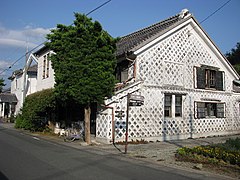Namako wall

Namako wall or Namako-kabe (sometimes misspelled as Nameko) is a Japanese wall design widely used for vernacular houses, particularly on fireproof storehouses by the latter half of the Edo period.[1] The namako wall is distinguished by a white grid pattern on black slate. Geographically, it was most prominent in parts of western Japan, notably the San'in region and San'yō region and, from the 19th century, further east, in the Izu Peninsula.[1]
Origin
As the base of the external walls of earthen kura storehouses is vulnerable to physical damage and damage from rain, they are often tiled to protect them. The exaggerated white clay joints that are a few centimetres wide and rounded on top remind people of namako sea cucumber.[2]
Modern uses
During the Meiji period (1868–1912), when Japan imported many Western ideas, the namako wall was used in a way that mimicked the "bricks and mortar" style of these countries. For example, Kisuke Shimizu's Tsukiji Hotel for foreigners in Tokyo Bay (completed in 1868) had namako walls that stretched from the ground to the eaves.[3]
The Misono-za kabuki theatre in Nagoya features a modern namako pattern on the facade.
-
 Blue-grey-purple tiles, plain, in an outdoor dado
Blue-grey-purple tiles, plain, in an outdoor dado - Kura (storehouse) in Tsuyama on the Izumo Kaido road showing diagonal namako tiling
-
 Wall of the Pontochō Kaburenjō Theater in Kyoto
Wall of the Pontochō Kaburenjō Theater in Kyoto -
 Namako wall in Matsuzaki, Shizuoka
Namako wall in Matsuzaki, Shizuoka -
 Keio Gijyuku Enzetsu kan (Speech hall)
Keio Gijyuku Enzetsu kan (Speech hall)
See also
- Japanese wall
Footnotes
References
- Itō, Teiji (1980). Kura: Design and Tradition of the Japanese Storehouse. Madrona Publishers.
- Stewart, David B (2002). The Making of a Modern Japanese Architecture, From the Founders to Shinohara and Isozaki. Kodansha International.
External links
 Media related to Namako wall at Wikimedia Commons
Media related to Namako wall at Wikimedia Commons
- v
- t
- e
| Secular | |||||
|---|---|---|---|---|---|
| Religious |
|
| Secular | |||||
|---|---|---|---|---|---|
| Religious |
|
- Burdock piling
- Chigi
- Disordered piling
- Engawa
- Hisashi
- Irimoya-zukuri
- Irori
- Katōmado
- Katsuogi
- Kuruwa
- Moya
- Nakazonae
- Namako wall
- Nightingale floor
- Onigawara
- Ranma
- Sōrin
- Tamagaki
- Tatami
- Tenshu
- Tokonoma
- Tokyō
- Tsumairi
- Shibi
- Gates
- Approaches
- Ken
- Koku
- Ri
- Shaku
- Sun
| |
| National Treasures |
|
|---|---|















